
Exhibiting and stewarding the Cape Cod Museum of Art’s outstanding Permanent Collection of over 2000 artworks is integral to our mission. We are committed to the cultural enrichment of our community today and tomorrow, telling the story of Cape Cod through the lens of visual art. The Familial exhibition is the result of ongoing research. Our recently released online catalog of the permanent collection allows for internal and world-wide accessibility to detailed information of artworks in the collection with corresponding images. The completion of this major initiative removes boundaries of access due to geographic, social, or economic circumstances. I would like to thank Berta Walker, curator of the Berta Walker Gallery in Provincetown, MA, for helping us portray a more complete picture in Familial by offering her support through important gifts of art that help to paint a more complete picture of these creative families. - Benton Jones, Director of Art
Read about Familial in the Provincetown Independent
Read about Familial in the Enterprise Newspapers
Watch a video of Laura Shabott's February 17th lecture:
"A Closer Look at the Art & FAMILIAL Relationships of Regional Artists."
The Families of Artists in Familial
The 37 family groups below are listed in the order in which their artwork appears in the
Hope McClennen Gallery, starting on the left wall after you enter the exhibition.
Wall text was researched and written by the CCMoA Docents.
If you would like to learn more about an artist you see below, click on their name in blue. The link will take you to the Cape Cod Museum of Art's new Online Permanent Collection! Here you will see the artist's biography, a list of their works in the CCMoA Permanent Collection and additional images. Artists without a link are currently still in the accessioning process.


Herb Edwards
(spouse of Lillia)
Cranberry Bog, Early Spring, 2000
Oil on linen
Gift of the Artist
Lillia Frantin
(spouse of Herb)
Otono, View of Pedernal, 1995
Oil on canvas
Gift of Ann Bengtson
Herb Edwards (1940 -)
Lillia Frantin (1944 -)
Lillia Frantin and Herb Edwards are a husband and wife team of professional artists. Both are graduates of Pratt Institute and are credentialed as professors. As individual artists they collaborate, communicate and inspire each other while retaining their own personal vision and style.
Nature and painting "en plein air" provides inspiration to both artists. Frantin, a "Neo-Fauvist", creates highly decorative works with vivid color and textured brush work, full of dynamic vitality and rhythm. Edward's style, referred to as "Painterly Realism", possesses a lyrical quality with emphasis on color and light, capturing "that sense of place". They have traveled and exhibited widely, retiring to Falmouth in 1997, where they maintain both home and studio. Frantin says, "Art is fulfilling, we've built our lives around it."
Docent: Judy McElroy
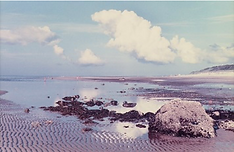
Anita Winstanley-Roark
(spouse of Robert)
Paine's Creek (1/10), n.d.
Color photograph
Gift of Dr. Linda B. Miller

Robert Roark
(spouse of Anita)
Coastal Sunrise, n.d.
Oil on canvas
Gift of Dr. Linda B. Miller
Anita Winstanley-Roark (1952-)
Robert Roark (1944-)
Robert Roark and Anita Winstanley-Roark are Cape Cod artists and art historians.
Robert Roark arrived in Provincetown in the 1960s to continue his studies as a protege of Henry Hensche. Revered as a “Master of Light and Realism”, he chooses to define landscapes and other subjects in terms of light, as opposed to color. His quality is so precise, so realistic, that one can mistake a painting for a photograph. He often photographs his subjects to record the changes in light before painting them.
Photographer Anita Winstanley-Roark studied under Aaron Siskin, Harold Jones and Todd Walker. It was her husband Robert's influence that inspired her interest in color photography. She aspires to "capture the beauty of light and shapes in direct images that would be missed in the rush of everyday life.”
Docent: Diane Depczenski
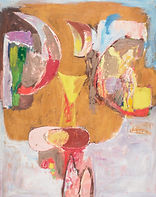

William Freed
(spouse of Lillian)
Impressions, 1958
Oil on canvas
Gift of Lillian Orlowsky and William Freed
Lillian Orlowsky
(spouse of William)
Untitled, late 1950s - early 1960s
Oil and fabric collage on canvas
Gift of the Artist
Lillian Orlowsky (1914-2004)
William Freed (1902-1984)
Married for 42 years, William Freed and Lillian Orlowsky shared a lifetime experiencing the changes in the American art movement, from Social Realism to Abstract Expressionism. They met in art class at a Lower Manhattan Settlement House, were employed by the WPA during The Depression, and in 1937 began studying with Hans Hofmann. After WWII they spent summers in Provincetown where they were active art colony members.
Each of these works is composed of bold colorful shapes and broad expressive brush strokes, creating depth and movement. There is also a hint of an underlying drawing. Freed referred to himself as an Abstract Realist; his earlier work often began from a still life drawing. Orlowsky’s imagery was usually based on reality.
Docent: Priscilla Hutchinson
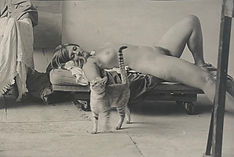
Blair Resika
(spouse of Paul)
Cat and Model (AP/10),
2005, Gelatin silver print
Promised gift by Berta Walker

Paul Resika
(spouse of Blair)
Red Roof, 1991
Oil on paper
Anonymous Gift in Honor
of Mr. Robert Duffy
Paul Resika (1928- )
Blair Resika (1937- )
Painter Paul Resika and photographer/singer Blair Resika celebrate the senses of sight and sound in their shared artistic life. Paul Resika’s work combines abstract and figurative elements with a strong color palette. He said, “Every day, I was in the (Provincetown) harbor at the same hour for three or four months of the year. The continual act of looking resulted in a distillation of form: elements are reduced to their most basic shapes, allowing light, color and atmosphere to take center stage.”
Blair Resika’s richly shadowed photography expresses the deep meaning she finds in everyday structures: unoccupied rooms, windows and doors. She credits her husband with encouraging her 25-year career in classical music. He has also been a frequent subject of her photography for over 40 years.
Docent: Nikki Alexander


Chaim Gross
(father of Mimi)
Dancers (5/12), 1963
Lithograph on paper
Gift of Pearl and Joel M. Wolfson
Mimi Gross
(daughter of Chaim)
Untitled, n.d.
Conte crayon on paper
Gift of Suzanne M. Packer
Chaim Gross (1904-1991)
Mimi Gross (1940-)
Chaim Gross emigrated to New York in 1921 from Austria-Hungary as antisemitism grew. He learned wood carving from his father’s lumber business. This medium led him to prominence in the 1930s as major museums acquired his sculpture while he was teaching at the New School and the Educational Alliance. He is also known for his drawings, prints and watercolors.
Daughter Mimi Gross grew up in a culture of art, influenced by her father, his contemporaries and even his students. Artist Raphael Soyer and Chaim’s student Louise Nevelson became mentors to Mimi, whose body of work includes portraiture, theatre sets and installations, some in collaboration with former husband Red Grooms. Though similarities exist between Chaim’s sculpture and Mimi’s 3-D and figurative work, Mimi felt that her father dismissed her work as too avant-garde.
Docent: Ellie Freedman


Marion Campbell Hawthorne
(spouse of Charles)
A Floral Still Life with Vase, n.d.
Oil on canvas
Gift of Mr. and Mrs. Joseph Hawthorne
Charles Hawthorne
(spouse of Marion)
Portrait of Anita, n.d.
Oil on masonite
Gift of Mr. and Mrs. Joseph Hawthorne
Charles Webster Hawthorne (1872-1930)
Marion Campbell Hawthorne (1870-1945)
Painters Charles Webster Hawthorne and his wife Marion Campbell Hawthorne both excelled as artists, yet chose different styles, mediums and subjects.
Charles Hawthorne, founder of The Cape Cod School of Art in Provincetown in 1899, grew in prominence for his figurative works. Painting mostly in oils, his style was structured and traditional. He loved Cape Cod with its humble people and painted them with distinction. His Portrait of Anita is an example of Hawthorne’s figurative work, using traditionally somber colors.
A passionate gardener, Marion Campbell Hawthorne primarily painted florals, though she also painted Provincetown village scenes in watercolor and gouache. Like most women artists of her time, she was steered toward a freer impressionistic style, as demonstrated here in A Floral Still Life with Vase.
Docent: Mary Ann Harward


Ada Rayner
(spouse of Henry)
Untitled, n.d.
Oil on board
Anonymous Gift in Honor of
Mr. Robert Duffy
Henry Hensche
(spouse of Ayda)
Portrait Study of Francis McWade, Summer 1952
Oil on board
Gift of M. F. McWade
Henry Hensche (1901-1992)
Ada Rayner (1901-1985)
Henry Hensche began his transition from tone-based painting to full spectrum color at Charles Hawthorne’s Cape Cod School of Art, the first school to teach outdoor figure painting. In 1928 he became Hawthorne’s teaching assistant, continuing the tradition upon Hawthorne’s death. Ada Rayner came to the United States from London in 1929 to escape the repressive socio-economic system of an old world. She settled in Provincetown, where she became Henry Hensche's "best student" and, in 1936, his wife.
Hensche, famous for his color block studies and "mud heads" (a method in which a live model is positioned in bright sunlight, with the painter capturing only patterns of light and shade rather than realistic details), is considered by many in the art world to be an unparalleled colorist. Ada Rayner became well known for her beautiful gardens as well as her painted landscapes, portraits and especially florals.
Docent: Shawn Dahlstrom

Reynolds Beal
(brother of Gifford)
The Commodore Morris
Whaler at New Bedford 1896,
1928, Aquatint on paper
(Monotype)
Anonymous Gift in Honor of
Mr. Robert Duffy

Gifford Beal
(brother of Reynolds)
Sword Fisherman, n.d.
Ink and watercolor on paper
Anonymous Gift in Honor of
Mr. Robert Duffy
Gifford Beal (1879-1956)
Reynolds Beal (1866-1951)
Brothers Reynolds Beal and Gifford Beal were born 13 years apart, the oldest and youngest in a family of six children. Reynolds Beal enjoyed a comfortable start in life. Gifford, however, was obliged to make his own way without a comfortable annuity from the family. Both brothers studied under William Merritt Chase at his summer school in Shinnecock Hills, Long Island and also in New York City.
The two brothers were sailors, and they created many paintings depicting the New England coastline. They traveled extensively and used a boat as a floating studio. In 1907 they shared exhibition space at the William Clausen Gallery in New York City. The career success of younger Gifford may have been a stimulus for older brother Reynold's transition from landscapes to the circus genre.
Docent: Ann Wolf
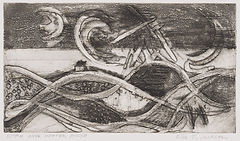
Ella Jackson
(spouse of Eugene)
Storm over Hopper House, n.d.
Etching on paper
Gift of Margaret Kamarck
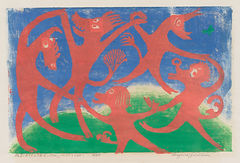
Eugene Jackson
(spouse of Ella)
No. I - Excusez-Moi, Matisse! (4/20), 1971-1976
Woodblock on paper
Gift of Arnold Elkind
Ella Jackson (1891-1982)
Eugene Jackson (1887- unknown)
New York City native Ella Jackson was a painter, woodcut artist, teacher and one of the founders of the Truro Center for the Arts at Castle Hill. Having studied at the Hans Hofmann School of Art in Provincetown, her work centered on the area’s natural beauty. The abstract rhythms of her masterful woodcut prints brought these scenes to life. She and her husband Eugene Jackson moved to Cape Cod permanently in the 1950s.
A distinguished linguist, scholar and author, Eugene Jackson began his second career at age 85. Persuaded by his wife to transform his casual doodling into woodcuts, his prints often featured fanciful animals. While their styles are distinctly different, husband and wife shared a love of their mutual medium and a supportive admiration of each other’s work.
Docent: Peter Adams

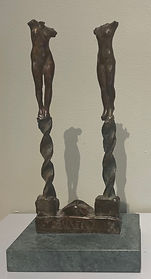
Salvatore Del Deo
(father of Romolo)
Eidolon, 1998
Charcoal on paper
Gift of the Artist
Romolo Del Deo
(son of Salvatore)
Bivio, 1993
Antique bronze
Promised gift by Berta Walker
Salvatore Del Deo (1928-)
Romolo Del Deo (1959-)
Salvatore Del Deo studied with Henry Hensche in Provincetown, settling there permanently with his bride Josephine in 1953. He was captivated by the rich subject matter at this lands' end: fishermen, artists, dunes, the sea. His significant contributions to the Provincetown Art Colony included helping to create art centers, art schools and museums.
A distinguished sculptor now working primarily in bronze, son Romolo Del Deo founded his own Studio/Art School and has received prestigious awards for his teaching methods based on the Long Art Movement. For both father and son, providing space, resources, knowledge and support to emerging artists is a priority.
Sal's Eidolon (meaning "spirit image") and Romolo's Bivio (meaning crossroads or divide) both feature defined yet mysterious nude figures. A close family unit, father and son have Provincetown studios within walking distance of one another.
Docent: Carolyn Duch

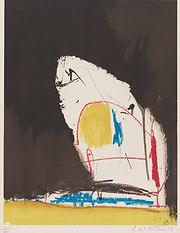
Renate Ponsold Motherwell
(spouse of Robert)
Robert Motherwell and
Wife Renate Ponsold, 1980
Black and white silver gelatin
print on RC paper
Gift of the Artist
Robert Motherwell
(spouse of Renate)
Capriccio (1/200), 1961
Collotype and photo silkscreen
on paper
Gift of Jack T. Ahlin
Renate Ponsold Motherwell (1935-2023)
Robert Motherwell (1915-1991)
Robert Motherwell was a painter, printmaker, collagist, teacher, writer and editor. He studied philosophy at Stanford and Harvard. Settling in New York in 1940, painting became his primary focus; his themes centered on the political, philosophical and literary. An eloquent speaker, he was an unofficial spokesman for the Abstract Expressionist movement.
Renate Ponsold visited New York City from her native Germany following graduation from photography and art school and decided to stay on, becoming immersed in the vibrant art world. Her black and white photographs were primarily portraits of artists and other creatives.
The couple met and married in 1972. Renate became Robert's documentarian, producing thousands of photographs of him, his art and exhibitions. They collaborated on illustrations - her photographs, his drawings - for a book of poetry excerpts.
Docent: Carolyn Duch
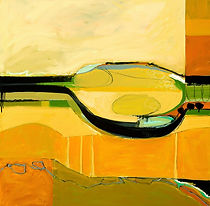
Carol Odell
(spouse of Tom)
Entering into Brightness, 2017
Oil on canvas
Promised gift by Carol and Tom Odell
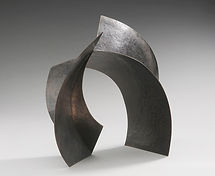
Tom Odell
(spouse of Carol)
Dark Corona, 2010
Bronze
Promised gift by Carol and
Tom Odell
Carol Odell (1943-)
Tom Odell (1948-)
Create artistic problems? Married couple Carol Odell and Tom Odell inspire each other to do just that, through their non-objective art.
Tom Odell explains, “Art should be ongoing and engaging and not always have the answer laid right out there for you.” Carol Odell adds, “We are aiming at evoking responses to a new image.”
Tom Odell creates his work to learn something. His metal sculptural compositions express harmony and rhythm using texture and color. Viewing his work, he says, “should be like listening to instrumental music.”
Inspired by the Cape’s coastal environment, Carol Odell references nature in her works, presenting that imagery through different forms, spaces and an abundance of color. Striving to create images that excite and engage viewers, she “tries to paint without nouns and enjoy the freedom of experimentation.”
Docent: Gina Lowe
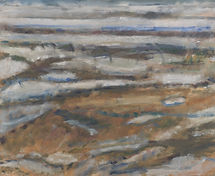

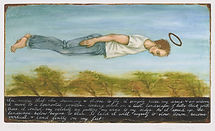
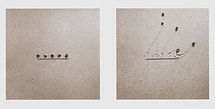
Tony Vevers
(spouse of Elspeth)
Winter Landscape, 1956
Oil on canvas
Gift of the Artist
Elspeth Halvorsen
(spouse of Tony)
Sun Ellipse, 1993 (revised 2015)
Mixed media assemblage
Gift of the Artist
Tony Vevers (1926-2008)
Elspeth Halvorsen (1929-2019)
Tabitha Vevers (1957-)
Daniel Ranalli (1946-)
Represented here are two generations of one family: spouses Tony Vevers and Elspeth Halvorsen, their daughter Tabitha Vevers and her husband Daniel Ranalli. All, with the exception of Ranalli, lived in Provincetown; Ranalli and wife Tabitha live part time in Wellfleet. Halvorsen and Tony Vevers were very active in the Provincetown art colony.
All four artists were stimulated by and inspired by the geography of the Outer Cape. In these works, we see that coastal geography is indeed significant, as each depicts a place, real or imagined.
One clear influence: Tabitha has said, in speaking about an earlier body of work, that her own use of gold leaf is a nod to her mother’s use of polished metal.
Docent: Judy Hadley
Tabitha Vevers
(daughter of Tony and Elspeth,
spouse of Daniel Ranalli)
David in Memoriam (22/35), 2005, Archival inkjet print with gold leaf
Gift of Chris & Sally Lutz
Daniel Ranalli
(spouse of Tabitha)
Snail Drawing: Line Start #6 (22/35), 2005
Archival inkjet print
Gift of Chris & Sally Lutz


Karin Rosenthal
(daughter of Margot)
Truro, Massachusetts, 2001
C-type print on photographic paper
Gift of Richard Polak
Margot Rosenthal
(mother of Karin)
Dunescape, n.d.
Oil pastel on paper
Gift of Richard Polak
Margot Rosenthal (1913-2010)
Karin Rosenthal (1945-)
Karin Rosenthal is the third generation of woman artists in her family. Her grandmother was a self-taught photographer who passed her knowledge on to her daughter, Margot Rosenthal, a professionally trained painter. Karin Rosenthal recalls, “I asked for a camera when I was six, and got a little box camera … I had already been hanging out in a darkroom in the basement of our house with my grandmother and my mother (Margot). And this was very unusual in my day, to have two female mentors like that and a darkroom. So, I was introduced to photography almost from birth.”
Margot and Karin were both fascinated by the dunes in Provincetown. When Margot got older and could no longer visit, Karin was photographing the dunes for her mother to draw inspiration from. Karin herself is best known for B&W abstract photographs of nudes in nature. Her landscape photographs often serve as a study and inspiration for her nudes.
Despite working in different mediums - Margot in oils, watercolor, collage and collagraphs and Karin in photography – both mother and daughter are inspired by nature and share an almost surrealistic sensibility.
Docent: Nikki Alexander
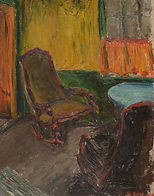

Evelyn Eastwood
(spouse of Thomas)
Rocking Chair, 1930s-1940s
Oil on canvas
Gift of Evelyn Eastwood
Thomas T. Eastwood
(spouse of Evelyn)
Channel Buoys, Staten Island, n.d.,
Oil on canvas
Gift of Evelyn Eastwood
Evelyn Eastwood (1907-2001)
Thomas Eastwood (1902-1957)
Thomas Eastwood and Evelyn Eastwood were both born in New Bedford, Massachusetts. Both studied at the Swain School of Design and Pratt Institute. They married and lived in New York from 1929-1944 and attended the Art Students League where they were shaped by Thomas Hart Benton, a friend of Jackson Pollock. Although they lived through the Great Depression and WWII, they also experienced the thrilling burgeoning of art museums in New York City, including the new Museum of Modern Art and Whitney Museum, institutions which promoted modern art stimulated by European artists.
In 1945 the Eastwoods settled in Hyannis where together they continued to paint and create macrame artifacts. Their paintings included landscapes, figures, still lifes and “spots" (small drawings) for The New Yorker magazine.
Docent: Cathy Hagopian
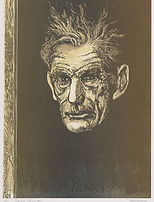
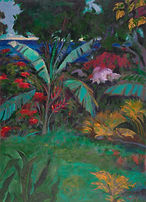
Jack Coughlin
(spouse of Joan)
Samuel Beckett (11/50), n.d.
Woodblock on paper
Gift of Joan Hopkins Coughlin/
Jack Coughlin
Joan Hopkins Coughlin
(spouse of Jack)
At the Edge of the Garden -
Wild Plantain, 1985
Oil on canvas
Gift of Joan Hopkins Coughlin/J
ack Coughlin
Jack Coughlin (1932-)
Joan Hopkins Coughlin (1936-)
Joan Hopkins and Jack Coughlin met at the Rhode Island School of Design (RISD) in the 1950s and married in 1958. They lived and pursued their art careers in western Massachusetts near Amherst, where Jack taught at University of Massachusetts for over 30 years. Summers are spent in Wellfleet, showing their work at their Golden Cod Gallery, the oldest gallery in Wellfleet at over 50 years.
Joan Hopkins Coughlin's art focuses on landscapes and still lifes. She uses bold brushstrokes and an abundance of color. A skilled printmaker, Jack Coughlin works in various mediums and themes representing the human figure, wild animals and surrealist depictions merging the two. RISD’s illustration and design program provided them with a shared language of composition and critique. They understand each other’s projects, offering advice in an ongoing dialogue.
Docent: Maureen Callahan

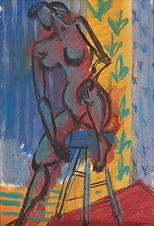
Blanche Lazzell
(cousin of Grace)
Abstract Long Point, 1933
Watercolor on paper
Anonymous Gift in Honor of
Mr. Robert Duffy
Grace Martin Taylor
(cousin of Blanche)
Female Seated Nude, n.d.
Watercolor on paper
Anonymous Gift in Honor of
Mr. Robert Duffy
Blanche Lazzell (1878-1956)
Grace Martin Taylor (1903-1995)
Blanche Lazzell and younger cousin Grace Martin Taylor both studied at West Virginia University. Lazzell first studied abroad and came to prominence as a founding member of the Provincetown Printers with pioneering work in white line printmaking, a method of color woodblock printing using a single block.
In 1929 Lazzell invited Taylor to come to Provincetown to learn this innovative technique. Both attended Hans Hofmann's summer classes in the 1940s. Hofmann’s modernist influence can be seen here, as both of these watercolors feature intense color and bold mark making.
Taylor largely spent her career as an art educator in West Virginia and was a founding member of the American Color Print Society. Lazzell remained in Provincetown, focusing on printmaking and watercolor throughout her career.
Docent: Ellie Freedman

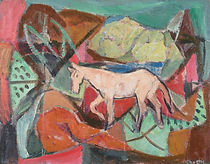
Ada Gilmore
(spouse of Oliver)
Thanksgiving, 1932
Watercolor on paper
Promised gift by Berta Walker
Oliver Newberry Chaffee
(spouse of Ada)
The White Horse, 1928
Oil on canvas
Gift of Mr. William M. Baxter
and Mr. Allen J. Ward
Oliver Newberry Chafee (1881-1944)
Ada Gilmore (1882-1955)
Oliver Chafee’s paintings were considered impressionistic and gradually evolved from representational to more abstract. Ada Gilmore, his second wife, was a pioneer of American modernism, a painter and wood block printer, whose prints of everyday life were noted for their soft colors and watercolor quality. Both husband and wife had been students of Robert Henri and were influenced by his training and work ethic.
After they married, Gilmore abandoned wood block printing for painting, possibly swayed by her husband as well as her contact with the work of the modernist masters. In their later work, both artists began using stronger colors as they developed different styles and depicted the edgier avant-garde modernism that was popular at the time.
Docent: Deborah Jacobs


Rachel Kaufman
(mother of Heather)
Paper Houses, n.d.
Pastel on paper
Gift of the Artist
Heather Blume
(daughter of Rachel)
Paper Play, 2016
Oil on canvas mounted on panel
Gift of 21 in Truro
Rachel Ellis Kaufman (1913-2001)
Heather Blume (1950 -)
As a child, Heather Blume remembers her mother, Rachel Ellis Kaufman, painting while encouraging her to go outside and explore. “She thought of me as a creative person, not as an artist per se. By age fifteen, I was working in clay and in my mid-thirties I made a conscious decision to devote my life to art,” says Blume.
Although their work is decidedly different, mother and daughter share a profound connection with Cape Cod and a sense of the surreal: Kaufman’s silent domestic interiors haunted by memories, Blume’s timeless mythological figures and psychological intrigues. Adds Blume, “At the end of her life, my mother and I had the chance to live together and become partners in the love, appreciation, and even mutual influence, of each other’s art.”
Docent: Nikki Alexander

Heather Blume
Interlude, 2011
Terra cotta
Gift of the Artist


John Joseph Enneking
(father of Joseph)
Old Brick House on the Neponset,
n.d.
Oil on canvas
Gift of Professor Morris Cohen
Joseph Eliot Enneking
(son of John)
Vista Through the Willows, n.d.
Oil on canvas
Gift of Professor Morris Cohen
John Joseph Enneking (1841-1916)
Joseph Eliot Enneking (1881-1942)
John Joseph Enneking is credited with ushering in American Impressionism almost a full generation before the Boston School. He favored natural settings like rocky brooks and woods. He explored the light at dusk in early spring and early fall. His son, Joseph Eliot Enneking, trained as an impressionist with his father and other renowned artists. Son Joseph also loved nature, often painting woodsy paths and beach scenes, preferring bright, sun-dappled canvasses. John Joseph Enneking was revered in his own time as “one of the world’s greatest landscape painters". His paintings have a strong sense of abstraction, giving them a dynamic composition. He used texture to capture and reflect light. Joseph Eliot's colors are more subdued; colors and lines are hatched into more static perpendicular rhythms.
Docent: Karen Pryce


Max Bohm
(grandfather of Anne)
Mother and Children, n.d.
Oil on canvas
Gift of Anne Packard
Anne Packard
(granddaughter of Max)
Dory, 2001
Oil on canvas
Anonymous Gift in Honor of
Mr. Robert Duffy
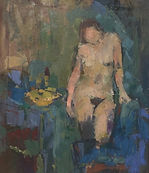
Cynthia Packard
(daughter of Anne)
Nude in the Interior, n.d.
Oil on canvas
Promised gift by Berta Walker
Max Bohm (1868-1923)
Anne Packard (1933-)
Cynthia Packard (1957-)
Max Bohm painted nature and emotion – the raw material of life. The family tradition of painting continues with his granddaughter, Anne Packard, and his great-granddaughters Cynthia Packard and Leslie Packard.
Anne Packard’s work rarely features people. “It’s not about loneliness,” Packard says. “It’s about solitude and nostalgia.” She zeroes in on her subject - a lone boat, a distant landscape, a big sky - each subject allowing her the space to intuit the scene.
Cynthia Packard said, “At the core, I'm an abstract painter, but I submit to an emotional urge to share my relationships—with nature, with people, even personal objects I've collected—which makes my work feel figurative. Painting is like a haiku. It gives the essence rather than giving everything.”
*Quotes taken from an article by Sue Harrison.
Docent: Shawn Dahlstrom
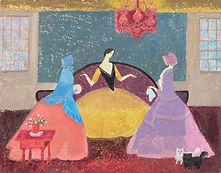
Dorothy Lake Gregory (spouse of Ross)
Interior Parlor, n.d.
Oil on board
Anonymous Gift in Honor of
Mr. Robert Duffy

Ross Moffett
(spouse of Dorothy)
Blue Heron, Pilgrim Lake, 1969
Oil on canvas
Gift of Robert Aron
Dorothy Lake Gregory (1893-1975)
Ross Moffett (1888-1971)
Ross Moffett and Dorothy Lake Gregory were students of Charles Hawthorne, founder of Cape Cod School of Art. They married in 1920. Ross Moffett became a legendary Cape Cod artist specializing in landscape painting, themed murals and etchings. He also painted Provincetown scenes including its beaches and harbors, fishing vessels and common people. He was an important figure in the development of Modernism in American Art.
Dorothy Lake Gregory was best known as a printmaker and illustrator of children’s books, of which she illustrated over 20. As with most women artists of this period, her artwork took second place to her family and supporting her husband.
Blue Heron, Pilgrim Lake shows his abstract, modernist approach. Her Interior Parlor seems designed for a printed work or illustration.
Docent: Mary Ann Harward

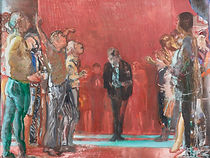
Selina Trieff
(spouse of Robert)
Head on Black, 1998
Oil and gold leaf on canvas
Gift of Del Filardi and Harriet Rubin
Robert Henry
(spouse of Selina)
Surprise Bravo, 1996
Oil on hypro mounted on canvas
Gift of Robert Henry
Robert Henry (1933-)
Selina Trieff (1934-2015)
Selina Trieff and Robert Henry met as students at Brooklyn College and married in 1954. Both studied with Hans Hofmann and Mark Rothko. They worked in adjoining studios in their Wellfleet home and were each other’s best critics.
Selina Trieff had a unique style, using gold and oil in her abstract figurative compositions. Her paintings are richly introspective. Robert Henry, also a figurative artist, has worked alone since his wife died in 2015. At a recent solo show at the Berta Walker Gallery in Provincetown he said, “Recently, I’ve gotten more involved in facial expressions. Some of it comes out of an appreciation of Selina’s work. Her figures always looked alive. You could communicate with them, and I want to get more of that into my work.”
Docent: Maria Ianzito
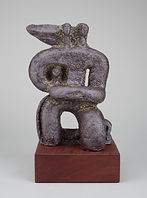



Arnold Geissbuhler
(father in law of Harry)
The Family, n.d.
Ceramic on wood base
Gift of Roy and Anne Freed
Harry Holl
(father of Sarah & Tina)
Vase, n.d.
Ceramic
Gift of Jerry and Patricia Adduci
Arnold Geissbuhler (1897-1993)
Harry Holl (1922-2014)
Sarah Holl (1958-)
Tina Holl (1950-)
To quote the American author and poet Suzy Kassem, “Family is like branches on a tree, we all grow in different directions, but our roots remain the same.” So it is with the family of noted sculptor Arnold Geissbuhler and his son-in-law potter Harry Holl. A founder of the Cape Cod Museum of Art and Scargo Pottery, Holl was an inspiration to his four daughters, who observed and absorbed his wisdom and craft. According to Holl, “You don’t learn by instruction, you have to discover yourself in your work”.
Using primarily clay, Geissbuhler, Harry Holl and daughter Tina Holl created distinctive sculptures, masks, reliefs and functional objects using a color palette of predominantly subtle earth tones. In contrast, daughter Sarah Holl is a multimedia artist, producing reliefs and sculpture in clay as well as paintings in acrylics and oils featuring bold, brilliant colors. All four artists blend classical and abstract elements inspired by the human form, animals, nature and the art of other cultures.
Docent: Barbara Hoos
Sarah Holl
(daughter of Harry; grandaughter of Arnold;
sister of Tina)
Figure Study, 1997
Oil on canvas
Gift of Rosalind Lawson Russell
Tina Holl
(daughter of Harry; grandaughter of
Arnold; sister of Sarah)
Untitled, n.d.
Clay
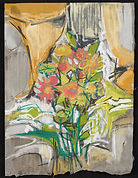
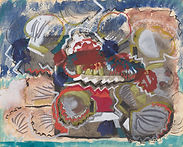
Karl Knaths
(brother in law of Agnes)
Untitled (Still Life), n.d.
Gouache on rice paper
Anonymous Gift in Honor of
Mr. Robert Duffy
Agnes Weinrich
(sister in law of Karl)
Clams, n.d.
Mixed media on paper
Gift of The Penny and
Elton Yasuna Collection
Karl Knaths (1891-1971)
Agnes Weinrich (1873-1946)
Karl Knaths grew up in the Midwest and studied at the Art Institute of Chicago. He then spent more than half a century in Provincetown, where he was influenced by European modernists like Cezanne, although he never ventured abroad. Knaths painted in a representational style at the beginning of his career. His painting later became more abstract, his inspiration being attributed to his sister-in-law, Agnes Weinrich.
Agnes Weinrich was an early member of the Provincetown Art Association and Museum (PAAM) and was known for her white line and cubist renderings. She led a group of young artists who experimented in Cubism. This created a rift between the traditional artists and the more modern and experimental artists at PAAM, leading them to split into two groups in 1927.
Docent: Gina Lowe



Thomas A. D. Watson
(brother of Cameron)
Dunn’s House, 1999
Oil on linen
Gift of the Artist
Francie Randolph
(spouse of Thomas)
Fiddlehead Reach (In the
Moment of Unravelling series), 2000
Mixed media on canvas
Gift of the Artist
N. Cameron Watson
(sister of Thomas)
Hostel, n.d.
Oil on linen
Gift of the Artist
Francie Randolph (1959-)
Thomas A.D. Watson (1965-)
Cameron N. Watson (1955-)
Lineage, location and love of artistic expression connect these three Cape artists. Thomas Watson and Cameron Watson are brother and sister. Their grandfather, Ernest Watson, was a renowned publisher and editor of the magazine American Artist and taught at Pratt Institute. Their grandmother, Eva Watson, was known for wood linocuts and oil paintings. Their father, Aldren A. Watson, produced exceptional pencil illustrations.
Given their inspiring familial heritage, it is not surprising that these third-generation artists would choose creative expression through the arts. Thomas is best known for his representational landscape paintings. Cameron, whose early artistic training was largely from family and self-study, pursued drawing and color theory at Yale University. Thomas’s wife, Francie Randolph, is a mixed-media artist who combines various printmaking and photographic techniques. All three hail from Truro, Massachusetts.
Docent: Barbara Potzka

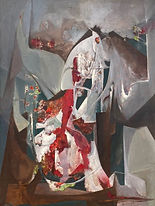
Boris Margo
(spouse of Jan)
Provincetown Harbor, n.d.
Oil on masonite
Gift of Yvonne Backus
Jan Gelb
(spouse of Margo)
The Great Beach: Wood’s Edge, 1961
Oil on canvas
Promised gift by Berta Walker
Boris Margo (1902-1995)
Jan Gelb (1906-1978)
Ukraine-born Boris Margo and New York City-born Jan Gelb married in 1941 and established their seasonal home in an isolated Provincetown beach shack. Margo, an inventor, painter, sculptor and printmaker, fell in love with the Cape’s landscape and included found beach objects in his work. Something of an artistic scientist, he invented the “cellocut,” (forerunner to other high relief printmaking techniques) and incorporated it into his surrealistic and abstract expressionist art.
A painter and printmaker, Jan Gelb’s work ranged from surrealism and dream imagery to abstract images. She said, “In both painting and graphics I start with automatism: I create a flowing of color, form, texture on their surfaces.” She, too, was inspired by the natural scenery of the Cape. Margo's inventiveness stimulated Gelb to devise new techniques to create textural effects in her prints.
Docent: Nikki Alexander
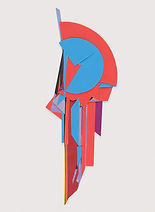

Budd Hopkins
(father of Grace)
Guardian Collage, 1993
Collage on paper
Gift of Grace Hopkins
Grace Hopkins
(daughter of Bud)
Portugal 30, 2019
Color photograph on aluminum
Promised gift by Grace Hopkins
Budd Hopkins (1931–2011)
Grace Hopkins (1973-)
Known for his hard-edged paintings, collages and architectonic sculptures, Budd Hopkins began as an abstract expressionist. He developed a unique style that placed abstraction in a color field, creating a balance between angles and circles and flatness with depth. He and his wife, April Kingsley, curator at MoMA and their daughter, Grace divided their time between Cape Cod and New York City.
Grace Hopkins thinks of herself as a photographer with the eye and soul of a painter. “Going to a museum with Dad was a lesson in what to look at,” Hopkins says. “He used to have my whole elementary school class over to our home every year to see his work.” Her images -- isolated fragments of something larger -- recall the geometric shapes and flat colors of her father.
Docent: Nikki Alexander


Coulton Waugh
(son of Frederick)
Low Tide - Provincetown, n.d.
Hand colored lithograph on paper
Gift of Richard & Rosanna Barons
Frederick Judd Waugh
(father of Coulton)
Coastal Scene, n.d.
Watercolor on paper
Anonymous Gift in Honor of
Mr. Robert Duffy
Frederick Judd Waugh (1861–1940)
Coulton Waugh (1896-1973)
Frederick Judd Waugh's first teachers were his father, portrait painter Samuel B. Waugh, and his mother, Mary Eliza Young Waugh, a miniaturist. A renowned marine painter, Frederick Waugh’s visceral style evoked the roar of the surf, the fizz of the foam and the scent of the sea air as massive rollers crashed into rocky shores.
Early works of son Coulton Waugh were also seascapes; later paintings depicted landscapes and still lifes. An author, cartoonist and master of the "painting knife" (he wrote an instructional book on painting straight from the tube with a knife), Coulton was known for his exuberant painting style, often featuring slashes of brilliant color. He also created pictorial maps and hand-colored lithographs.
Both father and son were inspired by and driven to express the dramatic beauty found everywhere in nature.
Docent: Nikki Alexander

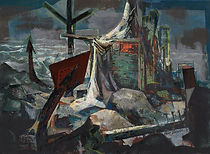
Ethel Edwards
(spouse of Xavier)
Marismas Iberia #19, 1985
Ink on paper
Gift of Ethel Edwards
Xavier Gonzalez
(spouse of Ethel)
Untitled, 1960
Acrylic on paper
Gift of Stuart and Kathleen Harrod
Ethel Edwards (1914-1999)
Xavier Gonzalez (1898-1993)
Married for 62 years, Xavier Gonzalez and Ethel Edwards were partners in life, love and art. Born in Spain, Gonzalez was a master painter, sculptor and teacher. New Orleans born Edwards was a painter, collage artist and illustrator. Both were known for murals, created primarily in Louisiana during the New Deal era. They met at Newcomb-Tulane College, where Gonzalez taught art and Edwards was his student. In 1942 the couple moved to New York City where they taught at the Art Students League for many years. They traveled and worked in France, Spain, Italy, Greece, Cambodia and Thailand.
In the 1950s the two artists discovered and fell in love with the light and landscape of the Outer Cape. They purchased a home in Wellfleet and opened an art school there.
Docent: Christine Young

John Whorf
(father of Nancy & Carol)
Floral Still Life, n.d.
Watercolor on paper
Anonymous Gift in Honor of Mr. Robert Duffy
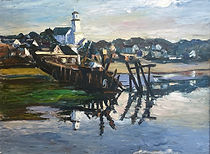
Nancy Whorf
(daughter of John)
Untitled, n.d.
Oil on canvas
Promised gift by Berta Walker

Carol Whorf Westcott
(daughter of John)
Cummaquid Gold, 1989-1990
Oil on canvas
Gift of Cummaquid Fine Arts
John Whorf (1903-1959)
Carol Whorf Westcott (1926-2008)
Nancy Whorf (1930-2009)
Descended from a long line of seafarers – his ancestors settled on Cape Cod in 1650 – John Whorf is best known for his seascapes. He also painted landscapes, still lifes and street scenes. He first painted in oils, later switching to watercolors. His paintings were described as showing the “vigor of youth” as can even be seen in the liveliness of this still life.
John Whorf’s daughters, Carol Whorf Westcott and Nancy Whorf, both developed an interest in painting as children by studying art with their father. Carol Whorf Westcott also studied at Rhode Island School of Design (RISD), Corcoran School of Art in DC and in summers with Henry Hensche in Provincetown. Despite a busy life that included raising six children, she still found time to pursue her passion and paint landscapes, portraits and still lifes.
Nancy Whorf continued her art studies at the Boston Museum of Fine Arts School. She started as a watercolorist but as she developed her own style she switched to oils and the drama of the palette knife. Although she painted portraits, still lifes, and even folk art on furniture, she is best known for her vibrant scenes of her beloved Provincetown.
Docent: Barbara Gray


Suzanne M. Packer
(spouse of Dick)
Tulips by the Bay, 2009
Oil on canvas
Gift of the Artist
Dick McGarr
(spouse of Suzanne)
Noon a Purple Glow, 2011
Acrylic on canvas
Gift of Robert Spohn
Suzanne Packer and Dick McGarr dazzle us with bold colors, dynamic shapes, vibrancy and feelings of movement.
Textured bursts of ripe primary colors in an abstract expressionist style characterize McGarr’s Noon a Purple Glow, drawing our eyes to geometric orange and indigo shapes in the center, as light filters in at the outer edges of his acrylic on canvas.
A riot of green stems and lively orange blooms emerge from the vase in Packer’s oil on canvas Tulips by the Bay. This is a reinterpretation of a charcoal by Ferol Sibley Warthen, whose use of straight lines to make shapes pleased Packer.
Side by side, the Packer/ McGarr paintings complement each other in form, hue, and motion, not unlike their marriage in life and art, where support and encouragement abound.
Docent: JoAnn Phillips
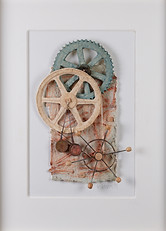

Philip Pieper
(spouse of Karen)
Clockwork Carnival I, 1995
Mixed media assemblage
Gift of Mary J. Lafleur
Karen LaFleur
(spouse of Philip)
Rebecca, © 2004/ ed. 2006
Digital narrative drawing on
archival paper
Gift of Mary J. LaFleur
Philip Pieper (1949-2002)
Karen LaFleur (1952-)
Philip Pieper’s works in metal and wood reflect an original perception of technology and industry. By revitalizing castoff industrial products, he challenged viewer's attitudes towards everyday technology, aspiring to reshape our perspective.
His widow Karen LaFleur is a “Techspressionist”: a digital artist who uses technology to express emotional experience. Her creations explore the interplay between interior and exterior worlds with a focus on adaptability. She reveals vulnerability in complex structures and highlights the resiliency of the human heart to survive within ever-shifting landscapes. Since 1981 she has used the computer to channel common interests into an all-inclusive medium.
Although husband and wife shared many common interests, LaFleur says they did not influence each other when it came to their art.
Docent: Christina Petruska
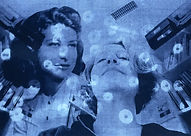

Amy Heller
(great niece of John)
Like Mother, Like Daughter, 2024 (first version made in 2015)
LED mixed media cyanotype on silk
Promised gift by Amy Heller
John Shayn
(great uncle of Amy)
Nature in the Raw, 1949
Gouache on paper
Promised gift by Amy Heller
John Shayn (1901-1977)
Amy Heller (1958-)
Ukraine born Jacob Sheinfine immigrated to America as a child and became John Shayn. He worked and studied in New York City and New England. Best known for biblically themed paintings (oil and watercolor) and illustrations, he also invented a wax color tempera medium.
Photographer and multimedia artist Amy Heller hails from Washington, DC and currently resides on Cape Cod. Her recent creations include LED mixed media cyanotype photographs on fabric, her own invention of sorts.
Heller recently purchased two paintings by her great Uncle "Jack" (Shayn) who, like her, painted in Provincetown, thus deepening her sense of connection to the uncle she'd never met.
Artistic similarities include a generous use of the color blue; frequent figural work, including nudes; triptychs and panoramic renderings; and surrealistic creative expression.
Docent: Carolyn Duch
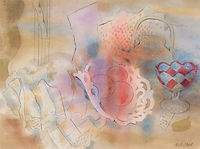


Ruth Cobb
(spouse of Lawrence,
mother of David)
Study with Ruby Chalice, 1995
Watercolor on paper
Gift of David Kupferman
Lawrence Kupferman
(spouse of Ruth; father of David)
Driftwood and Beach, c. 1946
Watercolor and ink on paper
Gift of Sara Gorfinkle
David Kupferman
(son of Ruth & Lawrence)
Cool Tide, JA: 6-2, 2001
Acrylic on paper
Gift of Anonymous Donor
Ruth Cobb (1914-2008)
Lawrence Kupferman (1909-1982)
David Kupferman (1946- )
David Kupferman credits his father with mentoring him and says of his family, “We had a very positive, prolific art life with everyone encouraging each other. My mother did wonderful still life paintings full of light from objects from the Cape and our spacious Victorian mansion in Newton where we all had studios during the year.”
Summers on Cape Cod, with its intense light and ocean vistas, and trips to Boston's Museum of Fine Arts’ collection of Asian art spurred their imaginations.
Lawrence Kupferman was Head of Painting at Massachusetts College of Art and Design. At first a realist, he moved to Abstract Expressionism.
David describes himself as a transformational lyric abstract painter as well as an expressionistic sea/sky artist.
Docent: Barbara Cole
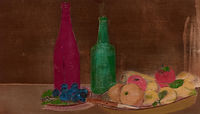

Seymour “Cy” Fried
(spouse of Miriam)
Fruit Arrangement with Grapes
(1/1), 1995
Photo aquatint on paper
Anonymous Gift in Honor of
Mr. Robert Duffy
Miriam Fried
(spouse of Cy)
Shoji (3-Fold Abstract Screen), 2000
Acrylic on masonite
Gift of Miriam Fried
Seymour "Cy” Fried (1917-2010)
Miriam Fried (1916-2014)
After 63 years of marriage, Cy and Miriam Fried had their relationship down to a science. They enjoyed painting back-to-back in their Provincetown studio, inspiring each other’s work. Cy said of their special bond, “We have thought transference. We put down our brushes at the same time, she asks me how I like something, and I ask her. We do it almost simultaneously and laugh.”
Cy specialized in gum printing, or photo aquatints, a technique that blurs the line between photography and painting. Miriam created visual excitement through the use of abstractions in color. Her collage work depicts nocturnal landscapes or seascapes, suggesting movement and form. Both were active in the Provincetown cultural community and fondly remembered as being inseparable, both in life and in art.
Docent: Barbara Potzka
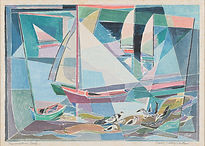

Ferol Sibley Warthen
(grandmother of Kathryn)
Provincetown Sails, 1955
White-line woodblock on paper
Gift of James G. Hinkle
Kathryn Lee Smith
(granddaughter of Ferol)
Ancestor Journey II #3, 2010
White-line woodblock on paper
Gift of the Artist
Ferol Sibley Warthen (1890-1986)
Kathryn Lee Smith (1953-)
At the age of four Kathryn Lee Smith began lessons with her grandmother, white line print artist Ferol Sibley Warthen. She says, “I remember her placing her hand over mine and showing me how to do it.” As a young woman Smith pursued painting and lithography, but the lure of white line printing called her back to its Provincetown origins and her grandmother’s expert knowledge of the form.
Smith also became a white line print educator, teaching traditional techniques while pushing its limits with her own work’s contemporary imagery. She adds, “I’m very fortunate to have grown up under my grandmother’s tutelage. She gave me something that has stayed with me and informed my career. It’s a generational thing, a link to the pioneers of white line printing and then on to the next generation.”
Docent: Nikki Alexander


